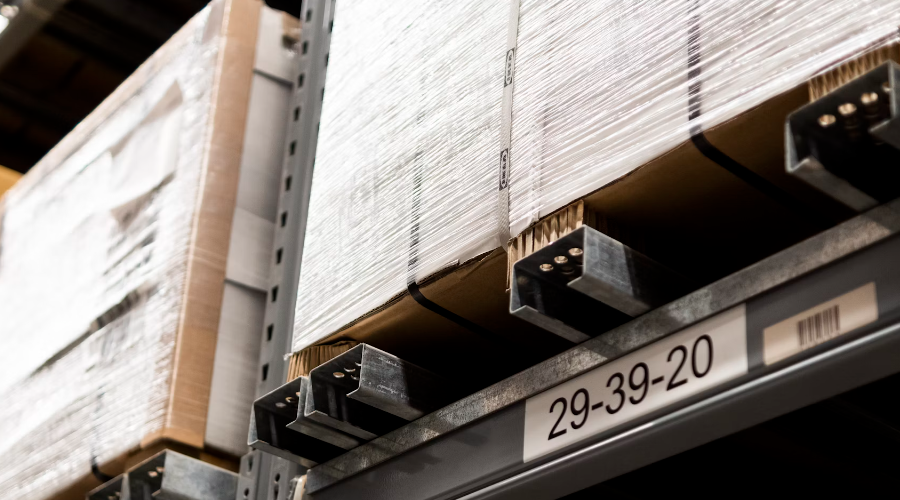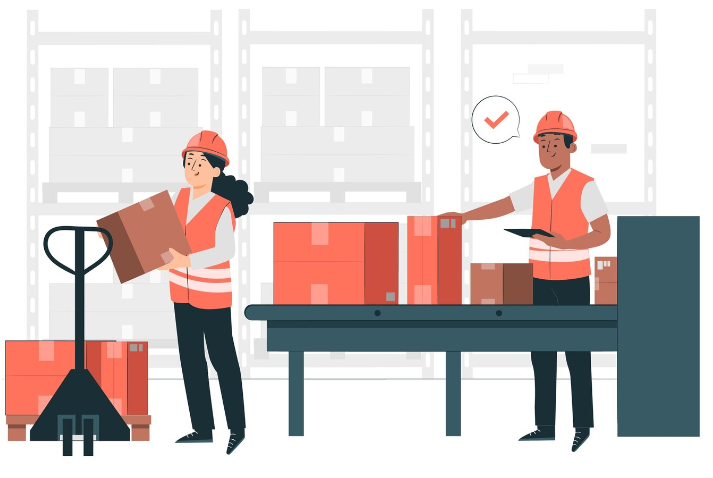Table of Contents
Get Custom eCommerce Fulfillment Service
Book a Meeting
How to Ship Large Items
Time: Jul 08,2024 Author: SFC Source: www.sendfromchina.com
Shipping large items involves a series of strategic decisions and careful handling to ensure safe and economical delivery. Whether you're shipping furniture, machinery, or other bulky goods, understanding the logistics involved will help ensure your items arrive safely and on time.
This guide will walk you through the process of shipping large items, from choosing the right carrier to packaging and tracking your shipment.

1. Understanding Large Items Shipping
In logistics, large items are defined as goods or products that exceed standard shipping dimensions and weight limits, necessitating specialized handling and transportation methods, including industrial machinery, vehicles, construction materials, large furniture, major appliances, raw materials in bulk, and components for marine or aerospace applications. Large items often require the use of heavy-duty equipment like cranes and forklifts, and specialized vehicles such as flatbed trucks or low loaders to accommodate their significant size and weight.
The transportation of large items involves adhering to specific regulatory requirements, including obtaining special permits and planning routes that can safely handle oversized loads. The logistics process for large items must ensure safe handling, secure packaging, and proper load balancing to prevent damage and ensure safety during transit. Due to these additional complexities, managing large items in logistics is typically more costly and requires detailed planning and coordination.
The transportation of large items involves adhering to specific regulatory requirements, including obtaining special permits and planning routes that can safely handle oversized loads. The logistics process for large items must ensure safe handling, secure packaging, and proper load balancing to prevent damage and ensure safety during transit. Due to these additional complexities, managing large items in logistics is typically more costly and requires detailed planning and coordination.
2. How to Ship Large Items

Before you learn how to ship large items, it is important to understand what is DIM weight.
What Is DIM Weight
DIM weight, short for "Dimensional Weight," is a calculation used in the shipping and logistics industry to determine the cost of shipping a package based on its dimensions rather than its actual weight. The new method helps carriers account for the space a package occupies in addition to its weight, ensuring efficient use of cargo space.
Dimensional Weight is calculated using the following formula:
DIM Weight=(Length×Width×Height)/DIM Factor
Dimensional Weight is calculated using the following formula:
DIM Weight=(Length×Width×Height)/DIM Factor
Length, Width, and Height: The dimensions of the package, usually measured in inches or centimeters.
DIM Factor: A standard divisor used by carriers to determine the dimensional weight. Common DIM factors are 139 (for domestic shipments in the U.S. using inches and pounds) and 5000 (for international shipments using centimeters and kilograms).
For example, if a package measures 20 inches in length, 15 inches in width, and 10 inches in height, and the DIM factor is 139:
DIM Weight=(20×15×10)/139=3000/139≈21.58 pounds
DIM Weight=(20×15×10)/139=3000/139≈21.58 pounds
After you learn the definition of DIM weight, here are the common steps to ship large items:
Choosing the Right Carrier
Selecting the right carrier is crucial for shipping large items. Consider carriers that specialize in oversized shipments, such as FedEx, DHL, or UPS. Evaluate their services, pricing, and reliability. Some carriers offer specialized services for large items, including white-glove delivery, which ensures your item is handled with extra care.
Packaging Large Items Securely
Proper packaging is vital to protect your large items during transit. Use sturdy boxes or crates that can withstand the weight and dimensions of your item. Reinforce the packaging with cushioning materials such as foam, bubble wrap, or packing peanuts to prevent damage. Make sure the item is immobile within the packaging to avoid shifting during shipping.
Labeling Large Shipments Correctly
Accurate labeling is essential for large item shipping. Ensure all labels are clear, legible, and placed on multiple sides of the package. Include all necessary information, such as the destination address, return address, and any handling instructions. Proper labeling helps prevent misdelivery and ensures the carrier handles your package appropriately.
3. Factors Affecting Large Items Shipping

Several factors can influence the shipping process for large items. Understanding these factors can help you plan and manage your shipments more effectively:
Size and Weight
Dimensions: Larger items may exceed standard size limits, requiring specialized equipment and vehicles for transport.
Weight: Heavier items necessitate the use of heavy-duty handling equipment and may require special permits for transportation.
Weight: Heavier items necessitate the use of heavy-duty handling equipment and may require special permits for transportation.
Regulations and Permits
Legal Requirements: Oversized or overweight shipments often need special permits, which vary by region and country.
Compliance: Adhering to local, state, and national regulations is essential to avoid fines and delays.
Compliance: Adhering to local, state, and national regulations is essential to avoid fines and delays.
Transportation Mode
Type of Vehicle: The choice of transportation (e.g., flatbed trucks, low loaders, specialized trailers) must accommodate the size and weight of the items.
Multimodal Transport: Combining different transportation modes (road, rail, sea, air) may be necessary for efficiency and cost-effectiveness.
Multimodal Transport: Combining different transportation modes (road, rail, sea, air) may be necessary for efficiency and cost-effectiveness.
Handling Equipment
Specialized Machinery: Cranes, forklifts, and other heavy-duty equipment are required for loading and unloading large items.
Expertise: Skilled operators are essential to handle large items safely and efficiently.
Expertise: Skilled operators are essential to handle large items safely and efficiently.
Route Planning
Infrastructure Constraints: Route selection must consider road width, bridge heights, weight limits, and potential obstacles.
Logistics Coordination: Detailed planning is required to ensure smooth transit, including coordination with local authorities and infrastructure managers.
Logistics Coordination: Detailed planning is required to ensure smooth transit, including coordination with local authorities and infrastructure managers.
Packaging and Protection
Secure Packaging: Proper packaging is crucial to prevent damage during transit. This may involve custom crates, padding, and secure fastening.
Environmental Protection: Ensuring items are protected from weather conditions and other environmental factors during transport.
Environmental Protection: Ensuring items are protected from weather conditions and other environmental factors during transport.
4. Tips to Ship Large Items
Shipping large items can be challenging, but following these tips can help ensure a smooth and efficient process:
Dimensions and Weight
First and foremost, it’s crucial to accurately measure the dimensions and weight of the item, including the packaging material. Precise measurements help determine the most suitable shipping method and prevent unexpected costs. Depending on the size and weight, freight services like Less Than Truckload (LTL) or Full Truckload (FTL) may be necessary, and sometimes a combination of road, rail, sea, or air transport can be the most efficient and cost-effective solution.
Right Package
Choosing the right packaging is essential to protect large items during transit. Use strong, durable materials such as wooden crates, heavy-duty boxes, or pallets, and include internal protection like padding, bubble wrap, or foam to prevent damage. Ensuring the item is securely fastened within its packaging is equally important to avoid movement during shipping.
Find a Reliable Carrier
Selecting a reliable carrier experienced in handling large items can make a significant difference. Ensure the carrier provides adequate insurance coverage to protect the item’s value. Careful route planning is also crucial; consider potential obstacles such as low bridges, narrow roads, and weight restrictions. Coordination with local authorities may be necessary for road closures or special permissions. Scheduling and timing play a key role; arrange for delivery during times when unloading can be efficiently managed and allow ample lead time to account for potential delays.
5. Case Study

UPS Pricing(10.5kg)(Sep, 27th, 2024)
| Zone 1 | Zone 2 | Zone 3 | Puerto Rico |
CA, Mex |
US | Zone 6 | Zone 7 | Zone 8 | Zone 9 | |
| Pricing (RMB) |
351 | 476 | 1398 | 1008 | 1071 | 1008 | 979 | 988 | 1247 | 1492 |
SFC Dedicated Line Pricing (USD)(Sep, 27th, 2024)
| US | CA | AU | Sweden | Spain | Italy | Hungary | Greece | Germany | France | |
| Pricing (USD) |
29.85 | 76.00 | 53.68 | 50.81 | 48.96 | 49.95 | 49.83 | 61.44 | 43.86 | 46.83 |
Most e-commerce sellers have a stereotypical view of cross-border logistics, only recognizing express services like UPS, USPS, and FedEx. Little do they know that compared to express services, dedicated lines can offer a better experience at a much lower cost.
6. Get Started with SFC Services
SFC stands at the forefront of order fulfillment with cutting-edge facilities in Shenzhen, China. Utilizing sophisticated software, we specialize in seamless and trustworthy fulfillment solutions for ecommerce, dropshipping, and crowdfunding platforms. At SFC, we are dedicated to accelerating your business growth through secure warehousing, efficient processing, customizable packaging options, and adaptable shipping strategies while saving you time and money.
Whether you have or do not have a fulfillment partner, particularly your products manufactured in China, you should consider SFC. Click the button below and get help from SFC logistics experts.
Whether you have or do not have a fulfillment partner, particularly your products manufactured in China, you should consider SFC. Click the button below and get help from SFC logistics experts.
What Makes SFC Special
Over 17 Years of 3PL and Order Fulfillment ExperienceAll-in-one Tracking Number
Popular Platform API Integration
30 Days of Free Storage
No Hidden Fee
Custom Packaging
Worldwide shipping solutions
Value-added Services
7. FAQs about Large Items Shipping
What is the cheapest way to ship large items?
The cheapest way to ship large items is usually via ground shipping with carriers like FedEx, UPS, or USPS. However, for very large or heavy items, using freight services or a 3PL may be more cost-effective. Always compare quotes from multiple carriers to find the best rate.
How do I package large items for shipping?
To package large items for shipping, use sturdy boxes or crates that can handle the weight and size of your item. Reinforce the packaging with foam, bubble wrap, or packing peanuts. Ensure the item is immobilized within the package to prevent movement during transit.
What carriers are best for large shipments?
Carriers like FedEx, UPS, and DHL are excellent choices for large shipments. They offer specialized services for oversized items and have the necessary infrastructure to handle such shipments efficiently. Research each carrier’s offerings to find the best fit for your needs.
How can I track my large item shipment?
You can track your large item shipment using the tracking number provided by the carrier. Enter this number on the carrier’s website or use their mobile app to get real-time updates on the status and location of your shipment.
What should I do if my large item is damaged during shipping?
If your large item is damaged during shipping, immediately document the damage with photos and contact the carrier to file a claim. Provide all necessary documentation, including the original packaging, to support your claim. Follow the carrier’s procedures to seek compensation or replacement.
 Post Views:1935
Post Views:1935
Copyright statement: The copyright of this article belongs to the original author. Please indicate the source for reprinting.
Previous Post
Why Your Packages Get Stuck in Customs: Reasons and Solutions
Next Post
TAGS
Hot Research
Recent News
- Third Party Logistics Definition, Process, and Advantages
- What Is Ecommerce Fulfillment? The Definition, Process, and Benefits
- Where Does Shein Ship From
- Order Streaming Explained: The Future of Fast and Flexible Ecommerce Fulfillment
- What Is a Wall-to-Wall Inventory Count and Why It Matters for Your Warehouse Accuracy
Get Custom eCommerce Fulfillment Service
Book a Meeting
Get a Custom China Fulfillment Solution with FREE Storage for 30 Days
 Want to know about our services, fees or receive a custom quote?
Want to know about our services, fees or receive a custom quote?
 Please fill out the form on the right and we will get back to you within a business day.
Please fill out the form on the right and we will get back to you within a business day.
 The more information you provide, the better our initial response
will be.
The more information you provide, the better our initial response
will be.






 TAGS:
TAGS: